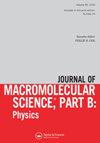多酚类黄酮与β-乳球蛋白的相互作用:分子对接与分子动力学模拟研究
IF 1.4
4区 工程技术
Q4 POLYMER SCIENCE
Journal of Macromolecular Science Part B-Physics
Pub Date : 2012-03-21
DOI:10.1080/00222348.2012.672854
引用次数: 46
摘要
采用分子对接和分子动力学模拟方法研究了槲皮素、槲皮素和芦丁等天然多酚类化合物与β-乳球蛋白(BLG)的相互作用。分子对接研究表明,槲皮素和槲皮素结合在蛋白质的内部空腔上,而芦丁因其结构体积大而结合在空腔的入口处。结果表明,BLG与槲皮素、槲皮素和芦丁分别存在一、三、四氢键相互作用。这表明,随着类黄酮结构中OH基团数量的增加,氢键相互作用的数量也在增加。槲皮素、槲皮素和芦丁与BLG的结合常数分别为1.2 × 106、1.9 × 106和7.4 × 104 M−1。分子动力学模拟结果表明,非配体BLG和BLG -配体配合物的均方根偏差(RMSD)在3500 ps后达到平衡。旋转半径研究表明,BLG和BLG -配体配合物在2500 ps左右稳定,与其他两种配合物不同,BLG -槲皮素没有构象变化。最后,对RMS波动的分析表明,在模拟过程中配体结合位点的结构保持近似刚性。本文章由计算机程序翻译,如有差异,请以英文原文为准。
The Interaction of Polyphenol Flavonoids with β-lactoglobulin: Molecular Docking and Molecular Dynamics Simulation Studies
The interaction of quercetin, quercitrin, and rutin, as natural polyphenolic compounds, with β-lactoglobulin (BLG) using molecular docking and molecular dynamics simulation methods was examined. Molecular docking studies showed that quercetin and quercitrin were bounded to the internal cavity of protein, while rutin was bounded to the entrance of the cavity because of its large structural volume. It was found that there were one-, three-, and four-hydrogen bond interactions between BLG and quercetin, quercitrin, and rutin respectively. This showed that with an increase in the number of OH groups in the flavonoid structure, there was an increase in the number of hydrogen bond interactions. The binding constants for the binding of quercetin, quercitrin, and rutin to BLG were 1.2 × 106, 1.9 × 106, and 7.4 × 104 M−1 respectively. The results of molecular dynamics simulation showed that the root mean square deviation (RMSD) of non-liganded BLG and BLG–ligand complexes reached equilibration after 3500 ps. The study of the radius of gyration revealed that BLG and BLG–ligand complexes were stabilized around 2500 ps, and unlike the two other complexes, there was no conformational change for BLG–quercetin. Finally, analyzing the RMS fluctuations suggested that the structure of the ligand binding site remained approximately rigid during simulation.
求助全文
通过发布文献求助,成功后即可免费获取论文全文。
去求助
来源期刊
CiteScore
2.50
自引率
21.40%
发文量
53
审稿时长
2.3 months
期刊介绍:
Devoted to the publication of significant fundamental contributions to the physics of macromolecular solids and liquids, both synthetic and natural, this international journal publishes original research in all of the areas generally included in both polymer solid state and liquid physics. This authoritative journal contains papers reporting research in transition mechanisms and structure-property relationships, the physics of polymer solutions and melts, of glassy and rubbery amorphous solids, and the physics of individual polymer molecules.

 求助内容:
求助内容: 应助结果提醒方式:
应助结果提醒方式:


